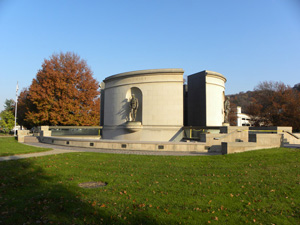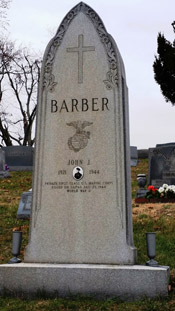

Remember...
John James Barber
1922-1944
"I have always considered Saipan the decisive battle of the Pacific offensive. (it was) the naval and military heart of the Japanese defence strategy."
Gen. Holland Smith
 |
Remember...John James Barber
|
John James Barber was born to James and Mary Barber, both born in Russia. John joined an older brother, Alex, in the family's rented home in Cassville, Monongalia County, in 1921. (It should be noted that while his cemetery monument gives a 1921 birth date, his draft registration card indicates he was born on July 21, 1922, and the latter date seems more plausible in that census records show he was 7 in 1930 and 17 in 1940.) Prior to establishing a home in Monongalia County, the family lived in Ohio (c. 1920, as the census indicates that's where Alex was born). James Barber, also known as Jim, was a loader in a coal mine, according to the 1930 Federal Census. Fellow Russian immigrant Frank Bon roomed with them. He also worked in the mine.
By the time the 1940 census data was collected, John was a truck driver employed in the Civilian Conservation Corps. The CCC was a component of President Franklin Roosevelt's New Deal programs that provided work:and income for their families:for young men during the Great Depression. The family was still in Cassville. James Barber was a track man in the coal mine. Alex, according to the census, was in school but John had advanced no further than eighth grade. Mary Barber did not have a job outside the home.
The Battle of Saipan was a brutal three-week assault on the islands. ("Battle of Saipan," 2009, History.com, accessed 20 July 2017, http://www.history.com/topics/world-war-ii/battle-of-saipan.) According to the History.com article,
On June 15, 1944, during the Pacific Campaign of World War II (1939-45), U.S. Marines stormed the beaches of the strategically significant Japanese island of Saipan, with a goal of gaining a crucial air base from which the U.S. could launch its new long-range B-29 bombers directly at Japan's home islands. Facing fierce Japanese resistance, Americans poured from their landing crafts to establish a beachhead, battle Japanese soldiers inland and force the Japanese army to retreat north. Fighting became especially brutal and prolonged around Mount Tapotchau, Saipan's highest peak, and Marines gave battle sites in the area names such as "Death Valley" and "Purple Heart Ridge." When the U.S. finally trapped the Japanese in the northern part of the island, Japanese soldiers launched a massive but futile banzai charge. On July 9, the U.S. flag was raised in victory over Saipan.
This short summary does not adequately portray the violence and desperation of the fighting, which resulted in the deaths of nearly 3,500 of Allied forces, but nearly 30,000 Japanese troops. It's estimated that 22,000 civilians on Saipan died of suicide at "Suicide Cliff."
According to a Fairmont Times death notice for Pfc. John Barber, published on September 17, 1944, his parents had received a letter from him written on July 17 in which stated he was in good health. The timing of Pfc. Barber's death seems especially tragic since he'd survived a brutal battle but was reported to have been killed sometime after the U.S. had declared victory. Research did not reveal the details of how this happened, but various sources describe the continuing actions on the island after the battle was declared won. Due to the number and extensiveness of caves and underground tunnels, actions to thoroughly contained pockets of resistance continued until 1945. ("Battle of Saipan," Wikipedia, accessed 20 July 2017, https://en.wikipedia.org/wiki/Battle_of_Saipan.)
 Courtesy Cynthia Mullens |
A tall monument to John J. Barber with his photo inset was erected in East Oak Grove Cemetery, Morgantown, West Virginia. Pfc. Barber was awarded the Purple Heart. |
Article prepared by Cynthia Mullens
May 2017

West Virginia Archives and History welcomes any additional information that can be provided about these veterans, including photographs, family names, letters and other relevant personal history.